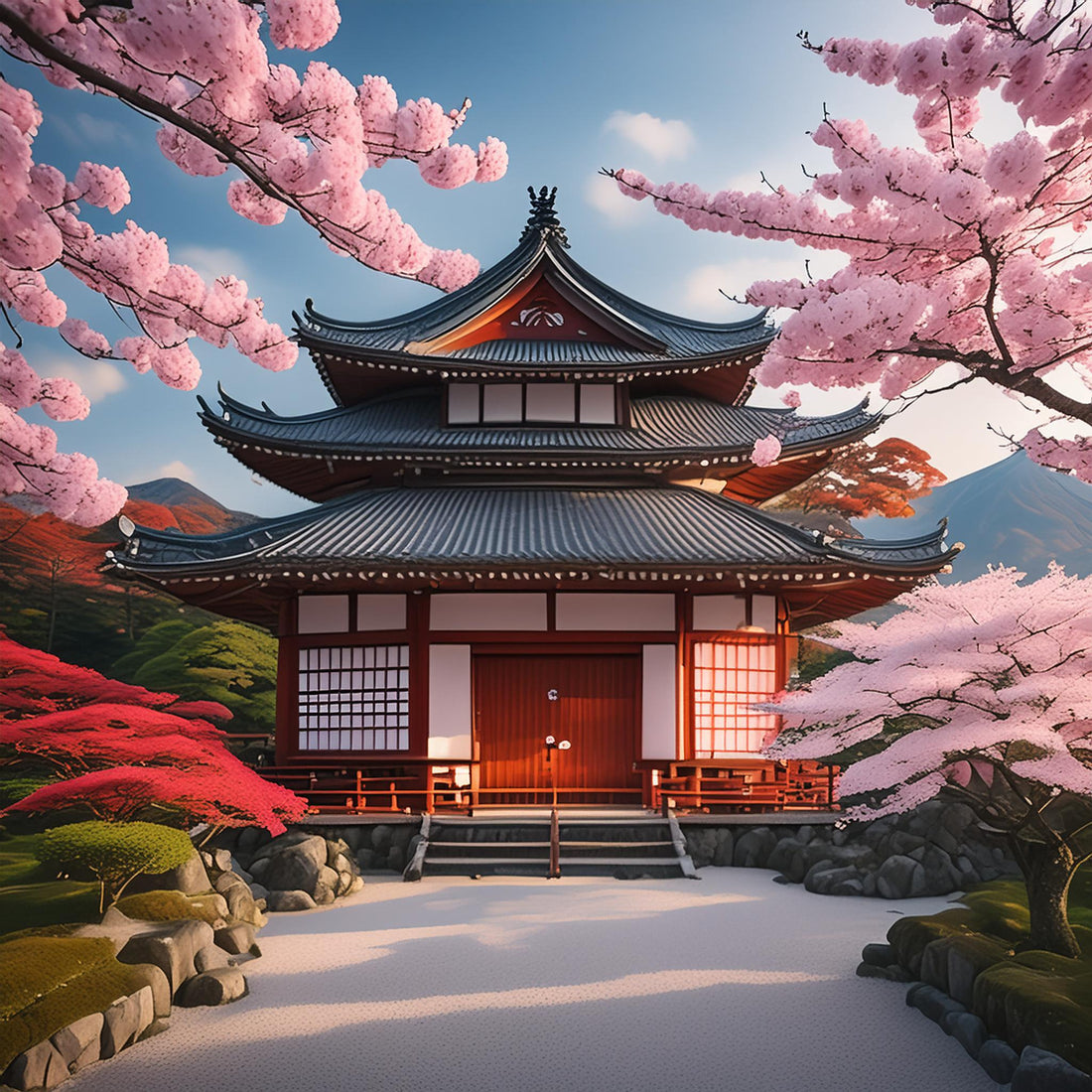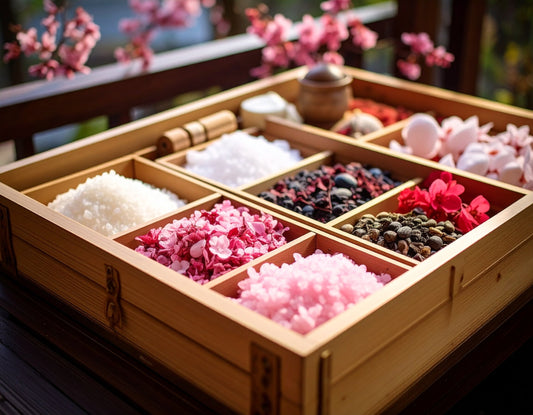
Japanese architecture: a captivating blend of history, tradition and modernity
Share
Japanese architecture fascinates with its captivating blend of history, tradition, and modernity. It is a true testament to Japan's rich culture and innovative vision. Over the centuries, Japanese architecture has evolved in harmony with the needs of society and technological advances, while retaining its traditional values.
Traditional Japanese buildings, such as temples and teahouses, are emblematic of Zen aesthetics and simplicity. They emphasize the use of natural materials such as wood and stone, as well as meticulous construction techniques.

But Japanese architecture isn't limited to traditional structures. Japan is also known for its futuristic skyscrapers, avant-garde buildings, and innovative designs. Japanese architects are constantly pushing the boundaries of creativity and creating unique spaces that rethink the way we live and interact with our environment.
Whether historic buildings or modern constructions, Japanese architecture is imbued with a sense of detail, quality, and harmony. It is this combination of history, tradition, and modernity that makes Japanese architecture so captivating and inspiring.
Characteristics of traditional Japanese architecture
Traditional Japanese architecture is characterized by its Zen aesthetic and simplicity. Buildings are designed to be in harmony with nature and create an atmosphere of calm and tranquility. Here are some of the key characteristics of traditional Japanese architecture:
- Use of natural materials : Traditional Japanese architecture emphasizes the use of natural materials such as wood, bamboo, and stone. These materials are chosen for their natural beauty and durability. Buildings are often constructed of wood to allow structural flexibility and withstand earthquakes.
- Meticulous construction techniques : Traditional Japanese construction involves sophisticated and meticulous techniques. For example, the "mokkou" technique allows for the creation of wooden joints without the use of nails or screws. Japanese carpenters are renowned for their expertise and precision in building construction.
- Use of space : Japanese architecture uses space efficiently and creatively. Rooms are often multifunctional, with sliding paper doors called "shoji" that allow spaces to be divided or opened as needed. Traditional Japanese houses are also known for their interior gardens, which are designed to be contemplative and calming.

These characteristics are found in various types of traditional Japanese buildings, such as temples, shrines, teahouses, and samurai houses. They demonstrate Japan's commitment to preserving its cultural heritage and unique aesthetic.
The influence of Buddhism and Shintoism on Japanese architecture
Japan is a country where Buddhism and Shintoism have coexisted for centuries, and both religions have had a profound influence on Japanese architecture.
Buddhism, which was introduced to Japan in the 6th century, brought with it architectural and artistic concepts from China and Korea. The first Buddhist temples in Japan were built according to Chinese architectural traditions but were later adapted to Japanese preferences and techniques.
The Evolution of Modern Japanese Architecture
Modern Japanese architecture is the result of constant evolution over the centuries. During the Meiji period (1868–1912), Japan opened its doors to the outside world and began to adopt Western influences in various fields, including architecture.
Japanese architects began incorporating elements of Western architecture into their works, leading to the creation of new architectural styles. For example, the "Western-style" (yoshiki) emerged, which blended Japanese and Western elements.
The 20th century saw a period of experimentation and innovation in Japanese architecture. Architects such as Kenzo Tange and Tadao Ando pushed the boundaries of creativity and created unique spaces that reimagined the way we live and interact with our surroundings.
The post-war period in Japan was also marked by massive reconstruction, which led to the construction of many modern and functional buildings. However, even in these newer buildings, one can often find references to traditional Japanese architecture, whether in the use of natural materials or in the creation of harmonious interior spaces.
Modern Japanese architecture is a unique blend of tradition and innovation. It demonstrates the ability of Japanese architects to adapt to the needs of society and technological advances while preserving traditional values of aesthetics and harmony.
Famous Japanese architectural styles: shoin-zukuri, sukiya-zukuri and minka
Japanese architecture is known for its many distinctive styles, reflecting both historical influences and regional preferences. Here are three famous Japanese architectural styles:
- Shoin-zukuri : Shoin-zukuri is a style of Japanese residential architecture that was popular during the Muromachi period (1336–1573). It is characterized by rectangular rooms with tatami floors and decorative alcoves. Rooms are often divided by sliding paper doors and wooden partitions called "fusuma." Shoin-zukuri is often associated with samurai residences.

- Sukiya-zukuri : Sukiya-zukuri is a style of Japanese architecture associated with teahouses and garden pavilions. It is characterized by its use of natural materials such as wood, bamboo, and rice paper. The buildings are designed to blend in with the surrounding nature, with garden views and openings to let in natural light.
- Minka : The term "minka" refers to traditional Japanese houses. These houses are often built of wood and have thatched or tiled roofs. Minka are examples of Japanese vernacular architecture, which varies depending on the region and climate. Minka are designed to be functional and durable, using local materials and construction techniques adapted to local conditions.
These famous architectural styles demonstrate the diversity and richness of traditional Japanese architecture. Each style has its own distinctive characteristics, but all share a keen attention to detail, quality, and harmony with nature.
Materials and techniques used in Japanese architecture.
Japanese architecture uses a variety of materials and techniques to create unique and durable buildings. Here are some of the main materials and techniques used in Japanese architecture:
- Wood : Wood is the most commonly used building material in Japanese architecture. It is valued for its natural beauty, durability, and structural flexibility. Different types of wood are used depending on their strength and local availability.
- Stone : Stone is often used in the construction of foundations, walls, and floors. It is valued for its strength and durability. Stone is often precisely cut and used in buildings such as temples and castles.
- Rice paper : Rice paper, known as "washi," is used for sliding paper doors ("shoji") and paper partitions ("fusuma"). It allows light to pass through while creating privacy and a warm atmosphere.
- Bamboo : Bamboo is used in Japanese architecture for its flexibility and durability. It is often used for lightweight structures, screens, and fences. Bamboo is also used for flooring, ceilings, and furniture.
Traditional construction techniques: Japanese carpenters are renowned for their skill and expertise in using traditional construction techniques. For example, the "mokkou" technique allows for the creation of wooden joints without the use of nails or screws. This technique allows for greater structural flexibility and improved earthquake resistance.
These materials and techniques are used with care and expertise to create buildings that are both functional and aesthetically pleasing. Japanese architecture is known for its build quality and durability, largely due to the use of these traditional materials and techniques.
Japanese gardens and their relationship with architecture
Japanese gardens are an integral part of Japanese architecture. They are designed to harmonize with the surrounding buildings, creating a holistic experience for visitors. Here are some of the key features of Japanese gardens and their relationship to architecture:
- Use of space : Japanese gardens are designed to use space efficiently and creatively. Garden elements, such as stones, trees, and ponds, are strategically arranged to create a sense of balance and harmony. Buildings are often positioned to frame views of the garden and create continuity between the indoor and outdoor spaces.
- Natural Elements : Japanese gardens often incorporate natural elements such as rocks, trees, and water. These elements are chosen for their natural beauty and their ability to create a serene and peaceful atmosphere. Japanese gardens are designed to be contemplative, offering visitors a space to relax and reconnect with nature.
- Symbolism : Japanese gardens are often designed with symbolic meaning. For example, ponds can represent the ocean, rocks can symbolize mountains, and bridges can represent the passage from one world to another. These symbolic elements are often in harmony with Buddhist and Shinto beliefs.
Japanese gardens are an integral part of Japanese architecture, creating a complete experience for visitors. They are designed to harmonize with the surrounding buildings, creating a serene and peaceful atmosphere. Japanese gardens are a testament to Japan's commitment to preserving nature and aesthetics.

Renowned contemporary Japanese architects
Japan is known for its many talented architects who push the boundaries of creativity and innovation. Here are some of the most renowned contemporary Japanese architects:
- Tadao Ando : Tadao Ando is one of Japan's most influential and celebrated architects. He is known for his minimalist, clean-lined buildings, which utilize natural materials such as concrete and glass. Ando has won numerous prestigious awards, including the Pritzker Prize, considered the "Nobel Prize of Architecture."
- Kengo Kuma : Kengo Kuma is another renowned Japanese architect known for his innovative use of natural materials. His buildings are often characterized by their use of wood and their harmonious integration with the surrounding nature. Kuma also designed the Tokyo National Olympic Stadium for the 2020 Olympic Games.
- Toyo Ito : Toyo Ito is an award-winning and visionary Japanese architect. His buildings are often characterized by their organic form and innovative use of light and space. Ito is known for his philosophy of "shadow architecture," which emphasizes creating interior spaces that are in harmony with their surroundings.
These contemporary Japanese architects are recognized worldwide for their creativity, innovation, and commitment to principles such as sustainability and harmony with nature. Their work continues to push the boundaries of what is possible in architecture and inspire future generations of architects.
The iconic buildings of Japanese architecture
Japanese architecture is marked by many iconic buildings that reflect its rich history and unique aesthetic. Here are some of the most iconic buildings in Japanese architecture:
- Kinkaku-ji Temple : Kinkaku-ji Temple, also known as the Golden Pavilion, is one of Japan's most famous landmarks. Located in Kyoto, it is covered in gold leaf, giving it a spectacular appearance. The temple is surrounded by a beautifully landscaped garden, a classic example of Japanese aesthetics.
- Himeji Castle : Himeji Castle, located in Hyogo Prefecture, is one of the best-preserved castles in Japan. It is famous for its defensive architecture, with its white walls and sloping roofs. Himeji Castle is an impressive example of Japanese feudal architecture and is a UNESCO World Heritage Site.

- Tokyo Skytree : The Tokyo Skytree is a broadcasting tower located in the Sumida ward of Tokyo. It is the tallest freestanding tower in the world, measuring 634 meters. The Tokyo Skytree is an iconic example of modern Japanese architecture, with its futuristic design and cutting-edge technology.
These iconic buildings represent the diversity and beauty of Japanese architecture and demonstrate Japan's commitment to preserving its cultural heritage and unique aesthetic.
Conclusion: The Importance of Japanese Architecture in Japanese Culture and History
Japanese architecture is much more than just a form of construction—it is an expression of Japanese culture and history. It reflects traditional values such as aesthetics, harmony with nature, and attention to detail, while incorporating modern influences and ideas.
Over the centuries, Japanese architecture has evolved to meet the needs of society and technological advances, while preserving its traditional values. Traditional Japanese buildings, such as temples and teahouses, are examples of the Zen aesthetic and simplicity that are characteristic of Japanese architecture.
Modern Japanese architecture, on the other hand, is known for its creativity, innovation, and use of natural materials. Contemporary Japanese architects push the boundaries of architectural design, creating unique buildings that rethink the way we live and interact with our environment.
Japanese architecture is also closely linked to other aspects of Japanese culture, such as Japanese gardens, religious traditions, and the arts. It is an integral part of Japanese identity and demonstrates Japan's commitment to preserving its cultural heritage.
Ultimately, Japanese architecture is captivating and inspiring because of its unique combination of history, tradition, and modernity. It represents the link between the past and the future, and is a testament to how architecture can shape our world and our experience of life. Whether in ancient temples or futuristic skyscrapers, Japanese architecture continues to captivate and amaze us.
Our O'Shiny Art & Lifestyle Collection
Discover unique pieces on our O'Shiny Art & Lifestyle website now and let the art of O'Shiny Art & Lifestyle transform your everyday life. Don't miss this opportunity to experience art in your daily life.
 "Cordelia" mug 11oz collection by O'Shiny Art & Lifestyle
"Cordelia" mug 11oz collection by O'Shiny Art & Lifestyle
Stay connected to explore more of O'Shiny Art & Lifestyle's artistic universe. Thank you for your interest.
Photos: © O'Shiny Art & Lifestyle "All rights reserved."



